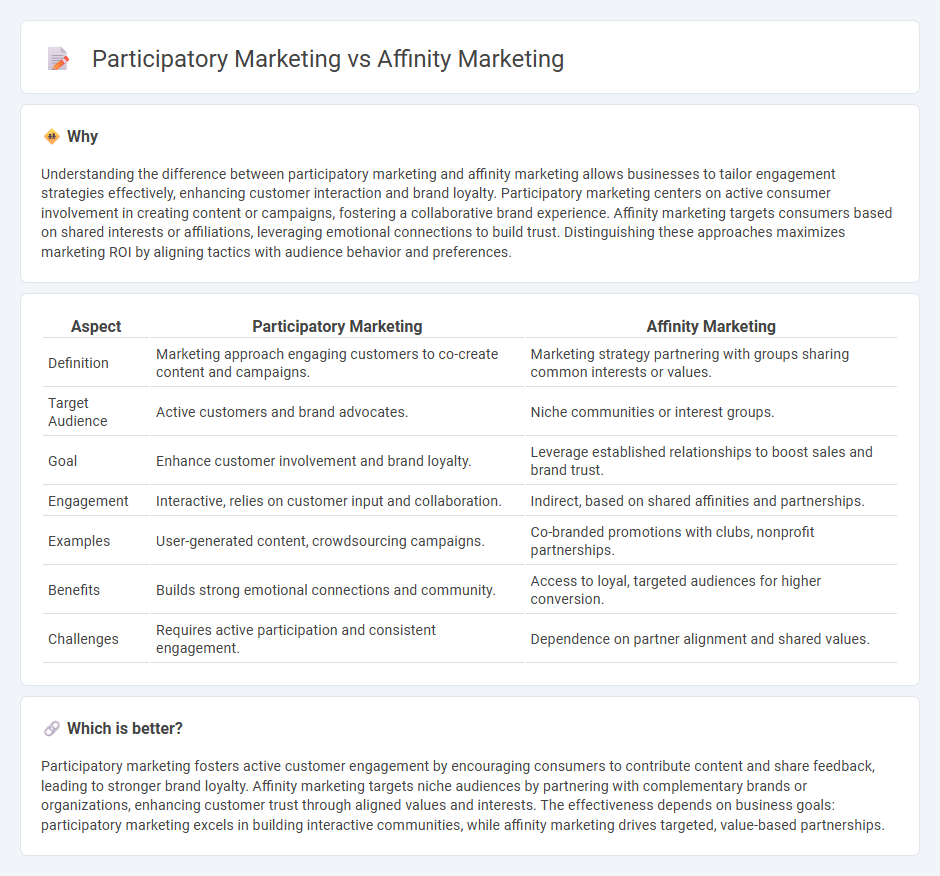
Participatory marketing engages consumers as active collaborators, fostering brand loyalty through direct interaction and shared content creation. Affinity marketing targets groups with shared interests or demographics, leveraging established connections to deliver tailored promotions. Explore how these strategies uniquely boost customer engagement and brand affinity.
Why it is important
Understanding the difference between participatory marketing and affinity marketing allows businesses to tailor engagement strategies effectively, enhancing customer interaction and brand loyalty. Participatory marketing centers on active consumer involvement in creating content or campaigns, fostering a collaborative brand experience. Affinity marketing targets consumers based on shared interests or affiliations, leveraging emotional connections to build trust. Distinguishing these approaches maximizes marketing ROI by aligning tactics with audience behavior and preferences.
Comparison Table
| Aspect | Participatory Marketing | Affinity Marketing |
|---|---|---|
| Definition | Marketing approach engaging customers to co-create content and campaigns. | Marketing strategy partnering with groups sharing common interests or values. |
| Target Audience | Active customers and brand advocates. | Niche communities or interest groups. |
| Goal | Enhance customer involvement and brand loyalty. | Leverage established relationships to boost sales and brand trust. |
| Engagement | Interactive, relies on customer input and collaboration. | Indirect, based on shared affinities and partnerships. |
| Examples | User-generated content, crowdsourcing campaigns. | Co-branded promotions with clubs, nonprofit partnerships. |
| Benefits | Builds strong emotional connections and community. | Access to loyal, targeted audiences for higher conversion. |
| Challenges | Requires active participation and consistent engagement. | Dependence on partner alignment and shared values. |
Which is better?
Participatory marketing fosters active customer engagement by encouraging consumers to contribute content and share feedback, leading to stronger brand loyalty. Affinity marketing targets niche audiences by partnering with complementary brands or organizations, enhancing customer trust through aligned values and interests. The effectiveness depends on business goals: participatory marketing excels in building interactive communities, while affinity marketing drives targeted, value-based partnerships.
Connection
Participatory marketing fosters customer engagement by encouraging active involvement in brand activities, which builds deeper emotional connections and community loyalty. Affinity marketing leverages these established relationships by targeting groups with shared interests or values, enhancing personalized offers and boosting conversion rates. Together, they create synergistic marketing strategies that enhance brand affinity and drive sustained customer participation through collaborative and interest-based interactions.
Key Terms
Affinity Marketing:
Affinity marketing targets specific consumer groups by leveraging shared interests, values, or affiliations to build strong brand connections and boost loyalty. This strategy often involves partnerships with organizations, clubs, or associations to offer tailored products or services that resonate deeply with the audience. Explore how affinity marketing can enhance your brand's engagement and drive targeted growth.
Strategic Partnerships
Affinity marketing leverages strategic partnerships by aligning brands with organizations that share a similar target audience, enhancing brand loyalty and expanding customer reach through co-branded products or services. Participatory marketing actively involves customers and partners in the marketing process, fostering engagement and collaboration to create authentic brand experiences. Explore how these approaches can powerfully drive your business growth through strategic alliances.
Shared Values
Affinity marketing emphasizes aligning with shared values between brands and specific groups to foster loyalty and community connection, leveraging common interests for targeted campaigns. Participatory marketing involves active engagement, encouraging consumers to co-create content and experiences that reflect their values, enhancing brand authenticity and deeper emotional bonds. Explore the unique benefits of each approach to harness shared values effectively in your marketing strategy.
Source and External Links
Affinity marketing - Affinity marketing is a partnership between a company and an organization with a shared interest group to expand the consumer base by leveraging social bonding and identification with the affinity group.
What is affinity marketing? | Definition from TechTarget - Affinity marketing is a direct marketing strategy where a business partners with an organization to access targeted, trusted affinity groups, enhancing brand loyalty and customer reach.
Affinity Marketing Definition & Strategies - Affinity marketing involves forming mutually beneficial partnerships between brands and affinity groups using shared incentives, third-party endorsements, and tailored campaigns to grow customers.
 dowidth.com
dowidth.com